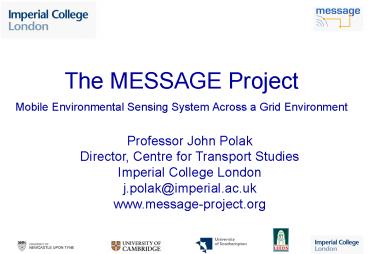The MESSAGE Project Mobile Environmental Sensing System Across a Grid Environment - PowerPoint PPT Presentation
1 / 19
Title:
The MESSAGE Project Mobile Environmental Sensing System Across a Grid Environment
Description:
3 year project starting October 2006 ... Gateshead. Leicester. Cambridge. Mobile Sensors. Gusto (5-10) & Motes ( 50) Motes (100) with GPS ... – PowerPoint PPT presentation
Number of Views:43
Avg rating:3.0/5.0
Title: The MESSAGE Project Mobile Environmental Sensing System Across a Grid Environment
1
The MESSAGE ProjectMobile Environmental Sensing
System Across a Grid Environment
Professor John Polak Director, Centre for
Transport Studies Imperial College
London j.polak_at_imperial.ac.uk www.message-project.
org
2
Outline
- Background and motivation
- Overview
- Challenges and innovation
- Field trials
- Conclusion
3
MESSAGE - headlines
- 3 year project starting October 2006
- Funded jointly by EPSRC and DfT under EPSRCs
e-Science demonstration programme - 5 Universities, 19 industrial partners
- Combination and extension of e-Science, sensor,
communication and positioning technologies - New sensing infrastructure based on combination
of ad-hoc mobile and fixed sensors
4
MESSAGE collaboration
5
MESSAGE - motivation
- Urban air quality is a major policy concern,
especially the role of road transport - Understanding vehicle emissions
- Understanding human exposure
- Managing network operations to optimise
congestion and air quality outcomes - Research and practice is hampered by lack of data
of sufficient spatial and temporal granularity - Opportunity to capitalise on low cost sensor,
positioning and communications technologies
6
MESSAGE overview
- Heterogeneous fixed and mobile sensors on
infrastructure, vehicles and people - Sensors communicate via wireless networks
- Positioning via GPS wireless cellular ranging
- Integration of processing along the data path
- Multiple application studies in different local
contexts
7
MESSAGE multi-disciplinarity
- MESSAGE involves integrating academic expertise
from several disciplines - 1Transport network modellers
- Air quality modellers
- Geomatricians
- Computer Scientists
- Electrical Engineers
- Sensor Developers (Physicists and Chemists)
- Together with industry experience and tangible
real-world applications
8
MESSAGE research challenges
- Field units
- Sensors
- Positioning
- Communications
- e-Science
- Scalability
- Distributed data mining
- Online estimation of pollutant hotspots
- Transport and environment modelling
- Traffic management and control
- Traveller information
9
MESSAGE field units
We are deliberately deploying a variety of
different sensor, positioning and communications
technologies, to ensure that the MESSAGE system
is generic
10
MESSAGE e-Science challenge
- We will build on the foundation of past e-science
projects (DiscoveryNet and OGSA-DAI) - Grid-enabled sensor service (a sensor is a
service generating data) - Semantically-described sensors (Sensor-ML)
- Sensor data collection and warehousing
- Querying distributed data storage
- Workflow based analysis of sensor data
- New challenge Scalable distributed analytics for
pervasive mobile heterogeneous sensors
11
MESSAGE e-Science innovation
- Development of sensor-level protocols to support
in-network analytics - Development of real-time in-network analytics
- Associated extensions of Discovery Net to support
in-network analytics
12
MESSAGE modelling innovation
- Existing transport and air quality models have a
simple centralised architecture - Need to evolve new forms of interpretive and
predictive transport models - accommodate multiple data sources and scales and
levels of behavioural richness - support distributed architectures
- Must stimulate academic and commercial innovation
in tool and service development and deployment
13
MESSAGE architecture
14
MESSAGE case studies
15
MESSAGE London case study
- Imperial and Newcastle sensor units
- Buses, fleet vehicles and street furniture
- Mobile deployment of heterogeneous systems
- Integration with existing TfL data streams
- Feedback to traffic management
16
MESSAGE London test site
- Camden High St.
- Multiple bus types
- Candidate routes
- 29
- 31
- 88
- 168
- 274
17
Opportunities
- MESSAGE is concerned with integrating a number of
technologies and approaches from within the
e-Science community and beyond - Although our context is urban air quality, the
concept of pervasive mobile sensing has much
wider application - Other application areas are being actively
developed
18
- Thank you
- www.message-project.org
19
Scalable eScience hardware

